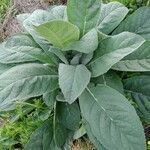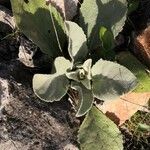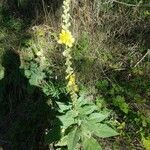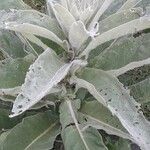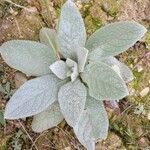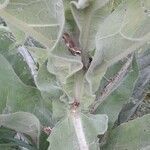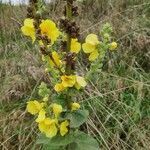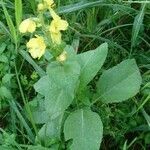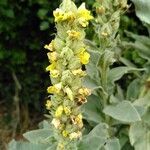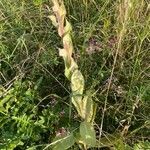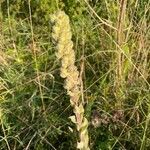Stout, erect, 1–2 m, usually densely gray-tomentose throughout; lvs entire or shallowly crenate, the lower oblong or oblanceolate, to 3 dm, petioled, the upper progressively reduced, sessile, decurrent along the stem to the next lf below; spike-like infl very dense, 2–5 dm × 3 cm, usually solitary; cor yellow, 1–2.5 cm wide; upper 3 filaments short, densely white-villous, with short anthers; lower 2 filaments much longer, glabrous or nearly so, with linear anthers; stigma capitate; 2n=32, 36. Native of Europe, now abundant throughout most of temperate N. Amer., especially in disturbed sites. June–Sept. A hybrid with no. 4 [Verbascum phlomoides L.] is V. ×kerneri Fritsch.
Biennials to 1.5 m tall, densely with grayish yellow stellate hairs. Basal and lower stem leaves petiolate; leaf blade oblanceolate-oblong, to 15 X 6 cm, margin crenate. Other stem leaves gradually decreasing in size upward, sessile, oblong to ovate-oblong, base decurrent into wings. Spicate panicle cylindric, to 30 X 2 cm, dense. Flowers usually few fascicled. Pedicel short. Calyx ca. 7 mm; lobes lanceolate. Corolla yellow, 1-2 cm in diam. Stamens 5; filaments of anterior 2 stamens glabrous and of posterior 3 pubescent; anther lobes divergent at base. Capsule ovoid, as long as persistent calyx. Fl. Jun-Aug, fr. Jul-Oct.
A stout herb. It takes two years to complete its life cycle. It can be 2.5 m high. The flowering stems are erect. The leaves, stems and outer flower parts have dense soft white hairs. There is a ring of leaves near the base. These are oval or sword shaped with a sharp tip. The leaf base narrows to a winged stalk. The leaves on the flowering stem get smaller and do not have a stalk. They have a wing which continues down the stem. The flowers are on a dense rod like structure. The flowers are in groups of 1-7 in the axils of bracts. The fruit is a dry round capsule.
